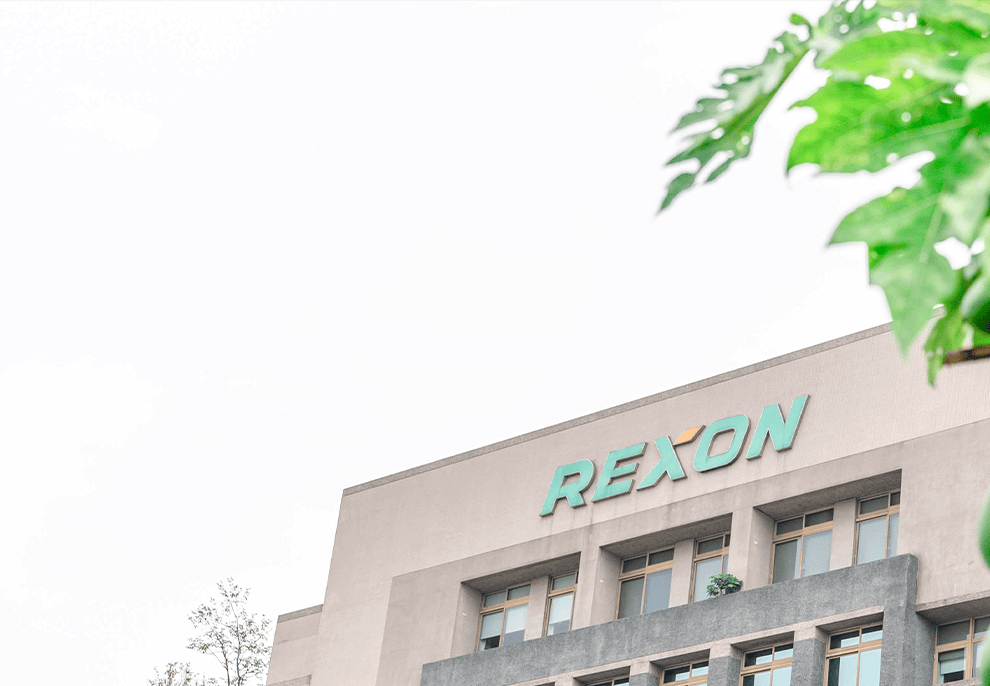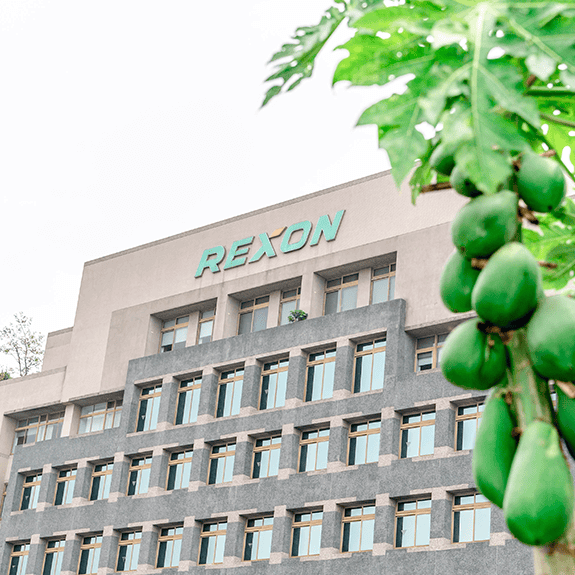CLIMATE ACTION POLICY
Climate Action Policy
Adopting the concept of resource sustainability, reviewing and assessing process operations and implementing a circular economy approach, establishing an energy management system.
Incorporating a product life cycle (see figure 1 on the right) management approach, considering product design, manufacturing, usage, and recycling stages to minimize the environmental impact of products. Actively seeking a balance between product functionality and environmental protection, and utilizing environmentally friendly materials as a starting point for design and development.
Management framework includes "Product Design Source Management," "Process Control and Pollution Reduction," "Circular Economy," and "Green Supply Chain Management" to achieve the goal of "Environmental Sustainability."
REXON ESG Strategy - Product Life Cycle
定期盤點,剩餘無法避免之排放量,透過購買國際認可碳權,達到碳中和/淨零排放
Suppliers

Customers
Supplier management and improvement
Transparency of supply chain impact
Design improvement, adopting materials with low environmental impact
Reducing material usage
Optimization of supplier transportation sharing
Active management of energy/resources
Replacement of outdated equipment to enhance energy efficiency
Reducing process waste
Substitution of fossil fuels
Increasing the use of renewable energy
Streamlining product design packaging to increase transportation efficiency and reduce the carbon impact
Improvement in product R&D design to reduce energy consumption during the usage stage
Environmentally friendly product design to promote a circular economy and reduce waste generation
CLIMATE ACTION MANAGEMENT
Climate Change Management
Rexon Industrial evaluates potential climate-related risks and opportunities based on the recommendations of the Task Force on Climate-related Financial Disclosures (TCFD). The company collects research on international climate change trends and industry-related trends to identify climate-related risks and opportunities. Subsequently, the company will assess the likelihood and impact of identified risks and develop climate change strategies and mitigation measures based on their significance.
TCFD Risk
Risk Description
Impact Duration
Financial Impact
Countermeasures
Corresponding Indicators
TCFD Risk
Acute Risk
Risk Description
Climate change impacts on upstream and downstream supply chains and transportation
Impact Duration
Short Term
(1-3 years)
Financial Impact
Decrease in revenue
Increase in expense
Countermeasures
- Assess the extent to which business locations are affected by physical risks and invest in corresponding disaster prevention equipment.
- Reduce the proportion of reliance on a single supplier, strengthen the management of raw material suppliers, and enhance operational resilience.
- Increase the proportion of long-term contracts in procurement and make early preparations.
Corresponding Indicators
- Number of assets or business activities susceptible to physical risks
- Proportion of single-source raw material suppliers
TCFD Risk
Policy Transition Risk
Risk Description
Development of energy management laws and regulations, including the mandatory use of renewable energy and the implementation of increased pricing for greenhouse gas emissions
Impact Duration
Medium Term
(3-5 years)
Financial Impact
Increase in expense
Countermeasures
- Evaluate the benefits of increasing the use of renewable energy and enhance the resilience of energy management.
- Increase investment in greenhouse gas emissions reduction to mitigate the potential impact of future policy regulations on businesses.
- Strengthen sustainable supply chain evaluation and management to minimize the impact of policy regulations on procurement.
Corresponding Indicators
- Consumption of renewable energy and its proportion in total energy consumption
- Greenhouse gas emissions
- Key supplier evaluation
TCFD Risk
Market Transition Risk
Risk Description
Increase in the cost of raw materials
Impact Duration
Long Term
(5-10 years)
Financial Impact
Increase in expense
Countermeasures
- Develop and research alternative raw materials.
- Establish a raw material forecasting management system.
Corresponding Indicators
R&D budget for raw materials
Rexon Net Zero Blueprint
2023 (Low Carbon)
2030
2050 (Net Zero Emissions)
Manufacture Improvement
Equipment replacement and automation
Inventory and hotspot analysis of high-energy-consuming equipment by plant area
High-energy-consuming equipment replacement
Intelligent energy management
Evaluation of intelligent energy monitoring system + ISO5001
Implementation of ISO5001
Establishment of an intelligent energy
monitoring system by plant area
Enhancement of production efficiency
PDCA improvement activities to enhance production efficiency
Waste reduction
Reduce scrap materials by 5% annually by Model
Energy Transition
Installation of solar energy systems
Installation of solar panels on rooftops
Integration into the internal power grid
Utilization of green energy
Evaluation of purchasing green energy certificates
15% utilization of green energy
Promotion of 15% green energy usage throughout the entire plant
Circular Economy
Substitution of raw materials
Carbon footprint assessment
Design improvement, adopting materials with low environmental impact
Material Flow Cost Accounting
(MFCA) Analysis
Establishment of MFCA system
Expansion to other new models
ENVIRONMENTAL PROTECTION MANAGEMENT
Environmental Protection Management
Rexon gradually implements management systems such as ISO 14001, ISO 45001, ISO 14064, and ISO 14067. The company conducts progressive carbon audits from organizational (categories 1-2) to transportation and supply chain emissions (categories 3-4). By 2027, complete data collection and carbon disclosure integrity of organizational category audits are expected. The company implements energy management performance indicators, promotes carbon management (carbon reduction, green energy procurement), and aims for net-zero carbon emissions by 2050.
Greenhouse Gas Management
Year
2021
2022
Revenue
(million NT dollars)
18,367
4,549
Type
Total Emissions
(tCO2e)
Percentage
(%)
Greenhouse Gas Emissions Intensity
(tCO2e/NTD million)
Total Emissions
(tCO2e)
Percentage
(%)
Greenhouse Gas Emissions Intensity
(tCO2e/NTD million)
Direct Greenhouse Gas Emissions
Category 1
(Direct Emission)
615.4887
0.19%
0.034
344.6211
0.36%
0.0758
Indirect Greenhouse Gas Emissions
Category 2
(Energy)
5,522.4190
1.67%
0.301
2,735.865
2.84%
0.6014
Category 3
(Transportation)
8,419.9188
2.54%
0.458
594.1112
0.62%
0.1306
Category 4
(Product Used)
316,505.8780
95.60%
17.232
92,575.1592
96.18%
20.3507
Category 5
(Use of Products)
0.0000
0.00%
0.000
0.0000
0.00%
0.000
Category 6
(Other Sources)
0.0000
0.00%
0.000
0.0000
0.00%
0.000
Total emissions
331,063.705
100.00%
18.025
96,249.7565
100.00%
21.1584
- The scope of the inventory in 2022 only includes the Taiwan headquarters and the Renhua plant in Taichung. In 2023, the Tucheng plant in Taichung will be further included. Subsequently, domestic and international sales locations and production sites will be gradually included according to the future greenhouse gas management schedule.
- The operational control approach is used to define the boundaries, and the calculation method adopts the emission factor approach.
- The emission factors used are referenced from the Environmental Protection Administration's Greenhouse Gas Emission Factors Management Table (Version 6.0.4, June 2019) for different emission sources. Other factors, such as carbon footprint information from the Product Carbon Footprint Information Network, Ecoinvent v3, mass balance calculations, Global Warming Potential (GWP) coefficients from the IPCC Fifth Assessment Report (2021), and carbon emissions from flights based on ICAO data, are used for conversion. In the future, if the government announces new factors, we will comply with the regulations of government agencies and adjust the selection of GWP coefficients accordingly.
- The emission factor for electricity used at the Taiwan headquarters is 0.509 tonnes of CO2e per kilowatt-hour (announced by the Bureau of Energy, 2021).
- The greenhouse gas emission intensity is calculated as the annual greenhouse gas emissions divided by the net consolidated revenue for the year (in million dollars).
Energy Conservation Measures and Pollution Control
Rexon has implemented energy-saving measures in its facilities, such as upgrading old energy-consuming facilities and process equipment (such as central air conditioning, process air compressors, and lighting improvement in the plant area), aiming to reduce energy consumption and decrease greenhouse gas emissions.
Energy Conservation Measures
Specific Actions and Environmental Expenses
Energy saving quantity / Cost savings
Reduction of Greenhouse Gases
Energy Conservation Measures
Replacing air conditioning equipment
Specific Actions and Environmental Expenses
Supporting the replacement of central air conditioning with variable frequency chillers in the building.
Equipment replacement cost in 2021: NT$10,448,092.
Energy saving quantity / Cost savings
Approximately 310,098kWh/year
NT$1,590,803/year
Reduction of Greenhouse Gases
Approximately 157.84 tonnes of CO2e/year
Energy Conservation Measures
Replacing air compressors
Specific Actions and Environmental Expenses
Replacing the 100HP variable frequency air compressor in the production building.
Equipment replacement cost in 2021: NT$1,524,075.
Energy saving quantity / Cost savings
Approximately 64,939 kWh/year
NT$250,665/year
Reduction of Greenhouse Gases
Approximately 33.19 tonnes of CO2e/year
Energy Conservation Measures
Replacing lighting fixtures
Specific Actions and Environmental Expenses
Upgrading the lighting in the production building from 40W fluorescent tubes to T5 LED tubes.
Total replacement of 562 tubes from 2019 to 2022
(19Y/68, 20Y/154, 21Y/268, 22Y/72).
Lighting replacement cost: NT$61,820.
Energy saving quantity / Cost savings
Approximately 24,676k kWh/year
NT$80,511/year
Reduction of Greenhouse Gases
Approximately 12.54 tonnes of CO2e/year
- The electricity cost savings for chillers are calculated based on the maximum energy consumption throughout the year, estimated at approximately NT$5.13/kWh. The electricity cost for air compressors and lighting is calculated based on an average unit price of NT$3.86 per kilowatt-hour as per the electricity bill.
- Reduction in emissions (tonnes CO2e) = Saved electricity (kilowatt-hours) * 0.509 tonnes CO2e. (The electricity carbon emission factor of 0.509 is the same as the 2021 report.)
- The energy saving of lighting equipment is the accumulated data since 2019.
Water Resources Management
Rexon has few water resource requirements and does not generate significant industrial wastewater. The company ensures that its water usage is lawful and does not have any environmental impact. Additionally, any wastewater generated by the company meets the required standards for discharge. There were no incidents of wastewater leakage in 2022.
Waste Management
Rexon fulfills its responsibilities as a global citizen by utilizing legal raw materials in its processes and entrusting qualified vendors to handle waste disposal. The company promotes the concept of recycling and urges its supply chain to reduce waste in compliance with regulations, while also maintaining proper documentation to track and verify compliance. In 2022, the total declared amount of waste generated by Rexon was 22.8 tonnes, and there were no violations or leakage incidents.
Type
Name
Treatment
2020
2021
2022
General business waste
Mixed plastic waste
Mixed paper waste
Incineration treatment
Incineration treatment
0.43
3.23
0.52
2.89
0.7
2.96
Hazardous business waste
Resin waste
Mixed oil waste
Heat treatment
Physical treatment
0
0
0
0
0.64
9.8
Domestic waste
Municipal solid waste
Incineration treatment
28.6
37.6
36.7
Total Amount
32.26
41.01
59.5
- Rexon follows the "Waste Disposal Act" issued by the Environmental Protection Administration of the Executive Yuan. Monthly statistical reporting is conducted to comply with the regulations. The reporting items include the category of industrial waste, whether it has hazardous characteristics, the method of disposal, and the total weight.
- Rexon disposes of waste off-site (the waste is transported to external facilities for proper disposal).
- The statistical period for waste management is from January 1, 2022, to December 31, 2022.



Corporate Sustainability Development Survey
To achieve more effective communication with stakeholders who care about our company,we sincerely invite you to take the time to complete this questionnaire.
Your participation will enable us to gain a better understanding of the issues that stakeholders are concerned about and enable us to respond actively.


